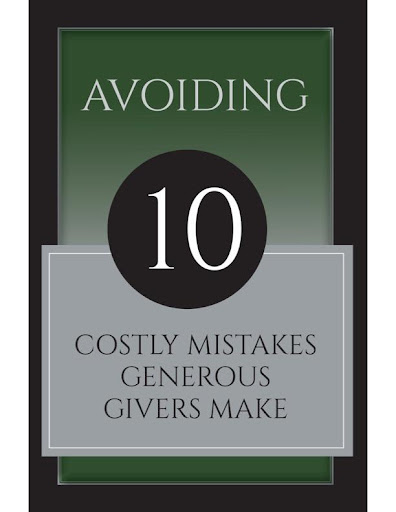Gilles new book Avoiding 10 Costly Mistakes Generous Givers Make (Strategic Resource Group, 42 pages) covers a topic we don’t see much from philanthropy and fundraising literature, especially literature from generosity organizations. Gilles sat down with several high-capacity donors to learn about their giving mistakes and what they learned from it.
Giving freely and generously is a common theme throughout the Bible. Those who have been blessed with extra are encouraged to help others in need so that everyone’s needs are met. Faithful stewardship means investing those funds in God’s Kingdom so that He can pass more through the giver to be reinvested in the Kingdom. Poor stewardship causes loss, and the Parable of the Ten Talents (Mt. 25:14-30) describes what happens to people who don’t use God’s money effectively.
Now raise the bar on stewardship expectations for high-capacity givers. God entrusts them with a significant amount of funds to produce greater results in His Kingdom. Many authors writing on generosity try to convince people to be generous givers. There are organizations dedicated to teaching people how to be more generous, and how to view all their assets as belonging to God. Many high-capacity givers respond to the teaching and give larger portions of their financial resources to ministry and social causes.
The problem is, few such organizations teach about how to be a wise and strategic investor of God’s money. As a result, people give large sums to social, mission, and ministry projects without doing the necessary due diligence and learning required to ensure the funds are not poorly spent. Costly giving mistakes are made.
The book covers 10 common mistakes. The mistakes discuss topics, such as entrepreneurship, risk taking, sustainability, opportunity cost, money vs relationships, gifts and donations vs investments, knowing how effective an organization is in achieving their visionary goals, and giving to the right kind of people. If a high-capacity giver can avoid the kind of mistakes described by their giving peers in this book from the start, they can avoid what one of the interviewed givers described as “a painful and lasting memory.” The author doesn’t assume givers won’t make giving mistakes of their own. We all make mistakes, but can we learn from other people’s mistakes and avoid those sooner.

The kinds of mistakes described in the book are not surprising for philanthropy. Givers are challenged to be more generous but finding organizations that can receive large grants without having to do a lot of due diligence is not a simple thing. Besides, nonprofit causes can really tug on our heart string, as it should. Their marketing pieces are inspiring and their impact goals admirable, so the giver takes the easier path and writes the big check based on the nonprofit’s messaging. It’s doubtful they would do that with a stock market investment decision. So it’s not a surprise when their large grant ends up being wasted if not underperforming in terms of impact on people and situations.
The book doesn’t just discuss mistakes. It also provides advice on what a giver could have done or should do to avoid making those kinds of mistakes. So it’s a great concise reference guide for doing due diligence before making a grant.
The book is available at Amazon.com.
Avoiding 10 Costly Mistakes Generous Givers Make
© Moving Missions 2022

